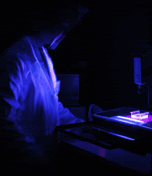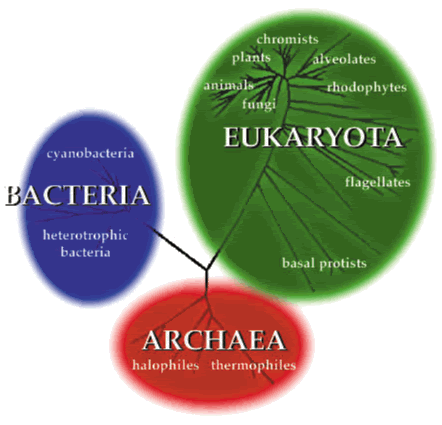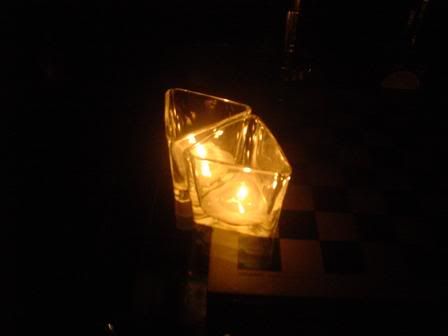LIFE'S EXTREMISTS?
Introduction to the Archaea
Older than dirt?

Life's extremists. . .This was some of the earliest research on Archaea. There are so many voices in these words just screaming, "HEY!!! Pay attention! "Pity no one ever really did. Slip them into laboratories and try to keep them all on their own slides so no one ever gets a full picture. Or DID they and it frightened them so dumb they couldn't bring themselves to admit that all of these different teensy beings were all actually the SAME thing in different forms?Look at the first pictures from Titan. 15 January 2005This composite was produced from images returned yesterday, 14 January 2005, by ESA's Huygens probe during its successful descent to land on Titan. It shows a full 360-degree view around Huygens. The left-hand side, behind Huygens, shows a boundary between light and dark areas. The white streaks seen near this boundary could be ground 'fog' of methane or ethane vapour, as they were not immediately visible from higher altitudes. As the probe descended, it drifted over a plateau (centre of image) and was heading towards its landing site in a dark area (right). This dark area is possibly a drainage channel which might still contain liquid material. From the drift of the probe, the wind speed has been estimated at around 6-7 metres per second. These images were taken from an altitude of about 8 kilometres with a resolution of about 20 metres per pixel.More about methane later....--------------------------------------------------------------------------------The Domain Archaea wasn't recognized as a major domain of life until quite recently. Until the 20th century, most biologists considered all living things to be classifiable as either a plant or an animal. But in the 1950s and 1960s, most biologists came to the realization that this system failed to accomodate the fungi, protists, and bacteria. By the 1970s, a system of Five Kingdoms had come to be accepted as the model by which all living things could be classified. At a more fundamental level, a distinction was made between the prokaryotic bacteria and the four eukaryotic kingdoms (plants, animals, fungi, & protists). The distinction recognizes the common traits that eukaryotic organisms share, such as nuclei, cytoskeletons, and internal membranes. The scientific community was understandably shocked in the late 1970s by the discovery of an entirely new, (NEW???) group of organisms -- the Archaea. Dr. Carl Woese and his colleagues at the University of Illinois were studying relationships among the prokaryotes using DNA sequences, and found that there were two distinctly different groups. Those "bacteria" that lived at high temperatures or produced methane clustered together as a group well away from the usual bacteria and the eukaryotes. Because of this vast difference in genetic makeup, Woese proposed that life be divided into three domains: Eukaryota, Eubacteria, and Archaebacteria. He later decided that the term Archaebacteria was a misnomer, and shortened it to Archaea. The three domains are shown in the illustration above , which illustrates also that each group is very different from the others.(I find this almost absurd on its face. Here are BEINGS that have been here for 4 BILLION years and in THEIR time, it might seem a mere batting of an eyelash, but for US, that would be 4 thousand, MILLION centuries, 4 MILLION millenia, and when did we show up? Its been a few centuries now that we have had the ability to find these marvels, but no one was looking. We should have been.)Further work has revealed additional surprises, which you can read about on the other pages of this exhibit. It is true that most archaeans don't look that different from bacteria under the microscope, and that the extreme conditions under which many species live has made them difficult to culture, so their unique place among living organisms long went unrecognized. However, biochemically and genetically, they are as different from bacteria as you are. Although many books and articles still refer to them as "Archaebacteria", that term has been abandoned because they aren't bacteria -- they're Archaea.Archaeans include inhabitants of some of the most extreme environments on the planet. Some live near rift vents in the deep sea at temperatures well over 100 degrees Centigrade. Others live in hot springs (such as the ones pictured above), or in extremely alkaline or acid waters. They have been found thriving inside the digestive tracts of cows, termites, and marine life where they produce methane. They live in the anoxic muds of marshes and at the bottom of the ocean, and even thrive in petroleum deposits deep underground.Some archaeans can survive the dessicating effects of extremely saline waters. One salt-loving group of archaea includes Halobacterium, a well-studied archaean. The light-sensitive pigment bacteriorhodopsin gives Halobacterium its color and provides it with chemical energy. Bacteriorhodopsin has a lovely purple color and it pumps protons to the outside of the membrane. When these protons flow back, they are used in the synthesis of ATP, which is the energy source of the cell. This protein is chemically very similar to the light-detecting pigment rhodopsin, found in the vertebrate retina.(Being early in the research phase, they did not realize that Archaea can create their own light with absolutely no other source of light to draw from and can live in the most ridiculously low, frigid temperatures whether it be in Antarctica or the cosmic winds. They are complete within themselves and can group together and become complete as something else as they will it. So there is no such thing as nothing, nowhere there isn't something, and we have never been alone in the universe.)Archaeans may be the only organisms that can live in extreme habitats such as thermal vents or hypersaline water. They may be extremely abundant in environments that are hostile to all other life forms. However, archaeans are not restricted to extreme environments; new research is showing that archaeans are also quite abundant in the plankton of the open sea. Much is still to be learned about these microbes, but it is clear that the Archaea is a remarkably diverse and successful clade of organisms.In the case of the Archaea, there is a very good candidate to preserve as a molecular fossil from the cell membrane. Archeal membranes do not contain the same lipids (oily compounds) that other organisms do; instead, their membranes are formed from isoprene chains. Because these particular isoprene structures are unique to archaeans, and because they are not as prone to decomposition at high temperatures, they make good markers for the presence of ancient Archaea.Molecular fossils of Archaea in the form of isoprenoid residues were first reported from the Messel oil shale of Germany (Michaelis & Albrecht, 1979). These are Miocene desposits whose geologic history is well known. Material from the shale was dissolved and analyzed using a combination of chromatography and mass spectrometry. These processes work by separating compounds by weight and other properties, and produce a "chemical fingerprint". The fingerprint of the Messel shale included isoprene compounds identical to those found in some archaeans. Based on the geologic history of the Messel area, thermophiles and halophiles are not likely to have ever lived there, so the most likely culprits to have left these chemical fingerprints behind are archaeal methanogens (methane-producers).(Chemical fingerprints. NOT fossils. Footprints in dried cement are not fossils. Handprints of movie stars in Hollywierd are not fossils. It only means they left prints. Period.)Since their discovery in the Messel shales, isoprene compounds indicative of ancient Archaea have been found in numerous other localities (Hahn & Haug, 1986), including Mesozoic, Paleozoic, and Precambrian sediments. Their chemical traces have even been found in sediments from the Isua district of west Greenland, the oldest known sediments on Earth at about 3.8 billion years old. This means that the Archaea (and life in general) appeared on Earth within one billion years of the planet's formation, and at a time when conditions were still quite inhospitable for life as we usually think of it.The atmosphere of the young Earth was rich in ammonia and methane, and was probably very hot. Such conditions, while toxic to plants and animals, can be quite cozy for archaeans. Rather than being oddball organisms evolved to survive in unusual conditions, the Archaea may represent remnants of once-thriving communities that dominated the world when it was young.It seems to me it means that Archaea were here in the beginning and never gave up an inch of territory. Since this was fairly early research, I can understand how easily their eternal uniqueness could be underestimated. I can't understand it anymore. Every clue as to what they are is apparent, even in the earliest research. So after all this time, and after it has been found virtually everywhere, I have to believe that science simply does not want to admit that these most minute of creatures are what comprise the whole of the universe, including the makeup of other life forms which include both us, and the opposite of us.It builds itself into whatever it needs to be, whatever it wants to be. They make up planets, stars, galaxies, moons, asteroids, comets, gases, liquid methane rivers, red rock, green leaves, blue waters, pink waters, winds, snow, hail, rain, dirt...animals we know and many life forms we don't know in many places we have never even seen yet.One of the questions in Job was how many children are in the universe. The answer is infinte because they cannot be numbered...and they continue to multiply so the universes expand exponentially. There might be as many universes as there are stars in the galaxies. When someone says a thing is impossible, I say that with G-d, all things are possible. A lot of people say that, but don't mean it.I mean it.3) Isoprenoid chains : The side chains in the phospholipids of bacteria and eukaryotes are fatty acids, chains of usually 16 to 18 carbon atoms. Archaea do not use fatty acids to build their membrane phospholipids. Instead, they have side chains of 20 carbon atoms built from isoprene. Isoprene is the simplest member of a class of chemicals called terpenes. By definition, a terpene is any molecule bilt by connecting isoprene molecules together, rather like building with Lego® blocks.Each isoprene unit has a "head" and a "tail" end (again like a Lego® block), but unlike their toy counterparts, isoprene blocks can be joined in many ways. A head can be attached to a tail or to another head end, and tails can be similarly joined. The immense variety of terpene compounds that can be built from simple isoprene units include beta-carotene (a vitamin), natural and synthetic rubbers, plant essential oils (such as spearmint), and steroid hormones (such as estrogen and testosterone).Duhhh!(4) Branching of side chains : Not only are the side chains of achaeal membranes built from different components, but the chains themselves have a different physical structure. Because isoprene is used to build the side chains, there are side branches off the main chain. The fatty acids of bacteria and eukaryotes do not have these side branches (the best they can manage is a slight bend in the middle), and this creates some interesting properties in archaeal membranes.For example, the isoprene side chains can be joined together. This can mean that the two side chains of a single phospholipid can join together, or they can be joined to side chains of another phospholipid on the other side of the membrane. No other group of organisms can form such transmembrane phospholipids.Another interesting property of the side branches is their ability to form carbon rings. This happens when one of the side branches curls around and bonds with another atom down the chain to make a ring of five carbon atoms. Such rings are thought to provide structural stability to the membrane, since they seem to be more common among species that live at high temperatures. They may work in the same way that cholesterol does in eukaryotic cells to stabilize membranes. It's interesting to note that cholesterol is another terpene!SMACK!!!I have ALWAYS known oil was never a fossil fuel. Earth needs it to survive so it always gets as much as it needs or we would grind ourselves into dust. Now, science knows it was never fossil fuel as well, but they still insist on repeating the lie for the same reason they won't flood the market with real diamonds. There's just too much money in keeping it scarce. Diamonds are worthless when you know that most of the diamonds in the world are tucked away somewhere to keep them off the market. If anyone ever decided to dump the diamonds out into the public, they wouldn't be worth one piece of beach sand.These little wonders are the miracle of creation itself so it can't be named Or numbered, but the number 7, which is the number assigned to G-d, is the number at which arrested atoms become dense matter. Do you think it got into the Book by sheer coincidence?We have been taught so many things and never paid attention. I take that back. I paid attention...and still do. Others should as well because not to is just stupid beyond belief.As of 1998, *science* remained convinced that the starstuff could only live in the harshest of environments. They were wrong. They are in the air we breathe. They are within and without. Do you realize that the membranes of your stomach withstand digestive fluids that could dissolve an aluminum pan. How do you think you DO that???An enzyme, alcohol dehydrogenase (ADH), is derived from a member of the archaea called Sulfolobus solfataricus. It works under some of nature's harshest volcanic conditions: It can survive to 88 deg. C (190 deg. F) - nearly boiling - and corrosive acid conditions (pH=3.5) approaching the sulfuric acid found in a car battery (pH=2). ADH catalyzes the conversion of alcohols and has considerable potential for biotechnology applications due to its stability under these extreme conditions.Fairly amazing, ain't it?Well, Truth finds a way if we are open to it. Why is it that so many of us simply do not want to know?OY!!!SHABBOT SHALOMSEZ NITZANA
15 January 2005This composite was produced from images returned yesterday, 14 January 2005, by ESA's Huygens probe during its successful descent to land on Titan. It shows a full 360-degree view around Huygens. The left-hand side, behind Huygens, shows a boundary between light and dark areas. The white streaks seen near this boundary could be ground 'fog' of methane or ethane vapour, as they were not immediately visible from higher altitudes. As the probe descended, it drifted over a plateau (centre of image) and was heading towards its landing site in a dark area (right). This dark area is possibly a drainage channel which might still contain liquid material. From the drift of the probe, the wind speed has been estimated at around 6-7 metres per second. These images were taken from an altitude of about 8 kilometres with a resolution of about 20 metres per pixel.More about methane later....--------------------------------------------------------------------------------The Domain Archaea wasn't recognized as a major domain of life until quite recently. Until the 20th century, most biologists considered all living things to be classifiable as either a plant or an animal. But in the 1950s and 1960s, most biologists came to the realization that this system failed to accomodate the fungi, protists, and bacteria. By the 1970s, a system of Five Kingdoms had come to be accepted as the model by which all living things could be classified. At a more fundamental level, a distinction was made between the prokaryotic bacteria and the four eukaryotic kingdoms (plants, animals, fungi, & protists). The distinction recognizes the common traits that eukaryotic organisms share, such as nuclei, cytoskeletons, and internal membranes. The scientific community was understandably shocked in the late 1970s by the discovery of an entirely new, (NEW???) group of organisms -- the Archaea. Dr. Carl Woese and his colleagues at the University of Illinois were studying relationships among the prokaryotes using DNA sequences, and found that there were two distinctly different groups. Those "bacteria" that lived at high temperatures or produced methane clustered together as a group well away from the usual bacteria and the eukaryotes. Because of this vast difference in genetic makeup, Woese proposed that life be divided into three domains: Eukaryota, Eubacteria, and Archaebacteria. He later decided that the term Archaebacteria was a misnomer, and shortened it to Archaea. The three domains are shown in the illustration above , which illustrates also that each group is very different from the others.(I find this almost absurd on its face. Here are BEINGS that have been here for 4 BILLION years and in THEIR time, it might seem a mere batting of an eyelash, but for US, that would be 4 thousand, MILLION centuries, 4 MILLION millenia, and when did we show up? Its been a few centuries now that we have had the ability to find these marvels, but no one was looking. We should have been.)Further work has revealed additional surprises, which you can read about on the other pages of this exhibit. It is true that most archaeans don't look that different from bacteria under the microscope, and that the extreme conditions under which many species live has made them difficult to culture, so their unique place among living organisms long went unrecognized. However, biochemically and genetically, they are as different from bacteria as you are. Although many books and articles still refer to them as "Archaebacteria", that term has been abandoned because they aren't bacteria -- they're Archaea.Archaeans include inhabitants of some of the most extreme environments on the planet. Some live near rift vents in the deep sea at temperatures well over 100 degrees Centigrade. Others live in hot springs (such as the ones pictured above), or in extremely alkaline or acid waters. They have been found thriving inside the digestive tracts of cows, termites, and marine life where they produce methane. They live in the anoxic muds of marshes and at the bottom of the ocean, and even thrive in petroleum deposits deep underground.Some archaeans can survive the dessicating effects of extremely saline waters. One salt-loving group of archaea includes Halobacterium, a well-studied archaean. The light-sensitive pigment bacteriorhodopsin gives Halobacterium its color and provides it with chemical energy. Bacteriorhodopsin has a lovely purple color and it pumps protons to the outside of the membrane. When these protons flow back, they are used in the synthesis of ATP, which is the energy source of the cell. This protein is chemically very similar to the light-detecting pigment rhodopsin, found in the vertebrate retina.(Being early in the research phase, they did not realize that Archaea can create their own light with absolutely no other source of light to draw from and can live in the most ridiculously low, frigid temperatures whether it be in Antarctica or the cosmic winds. They are complete within themselves and can group together and become complete as something else as they will it. So there is no such thing as nothing, nowhere there isn't something, and we have never been alone in the universe.)Archaeans may be the only organisms that can live in extreme habitats such as thermal vents or hypersaline water. They may be extremely abundant in environments that are hostile to all other life forms. However, archaeans are not restricted to extreme environments; new research is showing that archaeans are also quite abundant in the plankton of the open sea. Much is still to be learned about these microbes, but it is clear that the Archaea is a remarkably diverse and successful clade of organisms.In the case of the Archaea, there is a very good candidate to preserve as a molecular fossil from the cell membrane. Archeal membranes do not contain the same lipids (oily compounds) that other organisms do; instead, their membranes are formed from isoprene chains. Because these particular isoprene structures are unique to archaeans, and because they are not as prone to decomposition at high temperatures, they make good markers for the presence of ancient Archaea.Molecular fossils of Archaea in the form of isoprenoid residues were first reported from the Messel oil shale of Germany (Michaelis & Albrecht, 1979). These are Miocene desposits whose geologic history is well known. Material from the shale was dissolved and analyzed using a combination of chromatography and mass spectrometry. These processes work by separating compounds by weight and other properties, and produce a "chemical fingerprint". The fingerprint of the Messel shale included isoprene compounds identical to those found in some archaeans. Based on the geologic history of the Messel area, thermophiles and halophiles are not likely to have ever lived there, so the most likely culprits to have left these chemical fingerprints behind are archaeal methanogens (methane-producers).(Chemical fingerprints. NOT fossils. Footprints in dried cement are not fossils. Handprints of movie stars in Hollywierd are not fossils. It only means they left prints. Period.)Since their discovery in the Messel shales, isoprene compounds indicative of ancient Archaea have been found in numerous other localities (Hahn & Haug, 1986), including Mesozoic, Paleozoic, and Precambrian sediments. Their chemical traces have even been found in sediments from the Isua district of west Greenland, the oldest known sediments on Earth at about 3.8 billion years old. This means that the Archaea (and life in general) appeared on Earth within one billion years of the planet's formation, and at a time when conditions were still quite inhospitable for life as we usually think of it.The atmosphere of the young Earth was rich in ammonia and methane, and was probably very hot. Such conditions, while toxic to plants and animals, can be quite cozy for archaeans. Rather than being oddball organisms evolved to survive in unusual conditions, the Archaea may represent remnants of once-thriving communities that dominated the world when it was young.It seems to me it means that Archaea were here in the beginning and never gave up an inch of territory. Since this was fairly early research, I can understand how easily their eternal uniqueness could be underestimated. I can't understand it anymore. Every clue as to what they are is apparent, even in the earliest research. So after all this time, and after it has been found virtually everywhere, I have to believe that science simply does not want to admit that these most minute of creatures are what comprise the whole of the universe, including the makeup of other life forms which include both us, and the opposite of us.It builds itself into whatever it needs to be, whatever it wants to be. They make up planets, stars, galaxies, moons, asteroids, comets, gases, liquid methane rivers, red rock, green leaves, blue waters, pink waters, winds, snow, hail, rain, dirt...animals we know and many life forms we don't know in many places we have never even seen yet.One of the questions in Job was how many children are in the universe. The answer is infinte because they cannot be numbered...and they continue to multiply so the universes expand exponentially. There might be as many universes as there are stars in the galaxies. When someone says a thing is impossible, I say that with G-d, all things are possible. A lot of people say that, but don't mean it.I mean it.3) Isoprenoid chains : The side chains in the phospholipids of bacteria and eukaryotes are fatty acids, chains of usually 16 to 18 carbon atoms. Archaea do not use fatty acids to build their membrane phospholipids. Instead, they have side chains of 20 carbon atoms built from isoprene. Isoprene is the simplest member of a class of chemicals called terpenes. By definition, a terpene is any molecule bilt by connecting isoprene molecules together, rather like building with Lego® blocks.Each isoprene unit has a "head" and a "tail" end (again like a Lego® block), but unlike their toy counterparts, isoprene blocks can be joined in many ways. A head can be attached to a tail or to another head end, and tails can be similarly joined. The immense variety of terpene compounds that can be built from simple isoprene units include beta-carotene (a vitamin), natural and synthetic rubbers, plant essential oils (such as spearmint), and steroid hormones (such as estrogen and testosterone).Duhhh!(4) Branching of side chains : Not only are the side chains of achaeal membranes built from different components, but the chains themselves have a different physical structure. Because isoprene is used to build the side chains, there are side branches off the main chain. The fatty acids of bacteria and eukaryotes do not have these side branches (the best they can manage is a slight bend in the middle), and this creates some interesting properties in archaeal membranes.For example, the isoprene side chains can be joined together. This can mean that the two side chains of a single phospholipid can join together, or they can be joined to side chains of another phospholipid on the other side of the membrane. No other group of organisms can form such transmembrane phospholipids.Another interesting property of the side branches is their ability to form carbon rings. This happens when one of the side branches curls around and bonds with another atom down the chain to make a ring of five carbon atoms. Such rings are thought to provide structural stability to the membrane, since they seem to be more common among species that live at high temperatures. They may work in the same way that cholesterol does in eukaryotic cells to stabilize membranes. It's interesting to note that cholesterol is another terpene!SMACK!!!I have ALWAYS known oil was never a fossil fuel. Earth needs it to survive so it always gets as much as it needs or we would grind ourselves into dust. Now, science knows it was never fossil fuel as well, but they still insist on repeating the lie for the same reason they won't flood the market with real diamonds. There's just too much money in keeping it scarce. Diamonds are worthless when you know that most of the diamonds in the world are tucked away somewhere to keep them off the market. If anyone ever decided to dump the diamonds out into the public, they wouldn't be worth one piece of beach sand.These little wonders are the miracle of creation itself so it can't be named Or numbered, but the number 7, which is the number assigned to G-d, is the number at which arrested atoms become dense matter. Do you think it got into the Book by sheer coincidence?We have been taught so many things and never paid attention. I take that back. I paid attention...and still do. Others should as well because not to is just stupid beyond belief.As of 1998, *science* remained convinced that the starstuff could only live in the harshest of environments. They were wrong. They are in the air we breathe. They are within and without. Do you realize that the membranes of your stomach withstand digestive fluids that could dissolve an aluminum pan. How do you think you DO that???An enzyme, alcohol dehydrogenase (ADH), is derived from a member of the archaea called Sulfolobus solfataricus. It works under some of nature's harshest volcanic conditions: It can survive to 88 deg. C (190 deg. F) - nearly boiling - and corrosive acid conditions (pH=3.5) approaching the sulfuric acid found in a car battery (pH=2). ADH catalyzes the conversion of alcohols and has considerable potential for biotechnology applications due to its stability under these extreme conditions.Fairly amazing, ain't it?Well, Truth finds a way if we are open to it. Why is it that so many of us simply do not want to know?OY!!!SHABBOT SHALOMSEZ NITZANA































Home